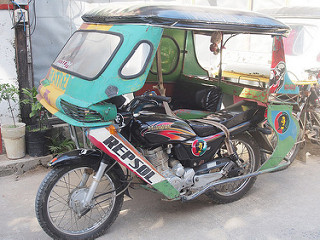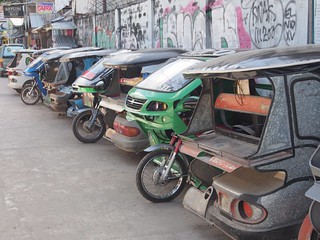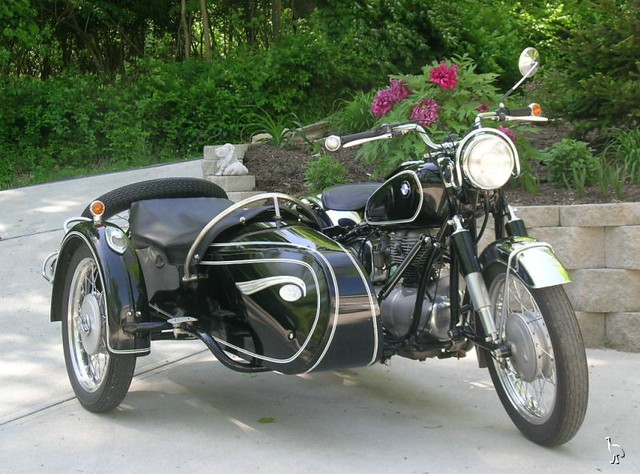Public transport safety, or the lack of it
(Posted in 2015, re-posted for consolidating my web presences)
I am quite tired of people telling me how dangerous riding motorbikes is. Yes, it is more dangerous than riding a car, BUT…
Tricycles are the major means of short distance transport in the rural Philippines. These vehicles come in different shapes, each province has its own flavour, but they have a few things in common:
They are based on commercial motorbikes, small Hondas, Kawasakis or Suzukis, or the occasional Chinese copy, although those are not so popular because of poor durability. These little bikes have between 70 and 150ccm and are designed to carry 2 people. They weigh below 120kg, add two big passengers and some luggage you might get a total weight of 300kg. Suspension, gears and brakes are accordingly fragile. For the tricycles based on these bikes: Adding the side car (estimated 250kg, but probably more), 4 passengers plus driver (4x60kg) and sometimes also luggage easily leads to a total weight of 600-700kg, so the weigh 2-3 times what the frame and brakes are designed for.
Many years ago I did own, fully restore and ride a BMW R25/2 with a Steib LS200 side car, like the one shown in the picture below. Having gone through a full restoration and five years of riding that bike, I know some things about side car geometrics, driving and braking performance etc. The wheel of the side car has to have a certain toe-in in order to make the vehicle go straight in a safe manner, in particular at high speeds. The bike itself should also lean slightly outwards, away from the side car. Last not least the side car wheel should be slightly (around 25-250 cm depending on the size of the vehicle) more forward than the rear bike wheel to prevent the bike from tipping over the front of the side car in extreme conditions. The local tricycles follow none of these guidelines, most of them even have the wheels aligned in the opposite way. One can see the effect, for example when even at quite low speed the front fork starts to wobble around like a dog’s tail.
Brakes of the motorbike are critical for small tricycles since the side car wheel usually does not have brakes. They have to be able to decelerate safely given the additional weight of the side car and the large number of passengers and luggage.
In terms of passenger safety, tricycles also have a very bad track record. The employee of a friend of mine had her hip bone smashed in a tricycle accident. It took her years to recover. The only good thing in terms of safety is that in case a lightning hits the tricycle perfectly protects the passenger from the lightning since it is a perfect faraday cage. In any other, more likely accident it is a trap. It also completely lacks any safety features like seat belts or crumple zones.
So given all this the local tricycle are by nature terribly unsafe vehicles. You therfore really want a tricycle you ride to be in top condition, will all brakes working and the side car wheel designed and aligned as good as possible too.
My last tricycle ride
During our 2015 Christmas holiday we rented a tricycle to bring us to a beach in Palawan because none of my group was into renting motorbikes, feeling too unsafe to drive themselves. The road to the beach, a 45 minute ride, was very curvy and went over several hills with steep climbs and drops. The first thing noticeable with the tricycle was that whenever there was a sharp left turn, the driver slowed down almost to walking speed, and the front wheel started wobbling twisting the fork heavily. Then, before every decent he slowed down too, and then went down very slowly, except there was a steep climb in sight in front of us, in which case he would even accelerate like a maniac in order to create some inertia to support the small, overworked engine uphill. When I watched him I saw that he was not using the front brake while going downhill, only the engine to brake. At one very steep hill he engaged the front brake but pulled the handle all the way until it touched the rubber of the accelerator. Great, no significant front brake at all, for everybody who knows anything about motorcycles it is clear that the front brake takes 70-80% of the braking force while the rear brake only 20-30%. That is because during the braking process the inertia shifts the weight towards the front, applying more force to the rear brake just makes the rear wheel stall without increasing the brake effect. Pure physics.
At the next stop I checked the front brake. The handle could be pulled to the end without any resistance. What about the rear brake then? I checked the pedal. Usually it should have a finger thick clearance before it responds. This one moved one hand width before it got some resistance. Not much good either.
So we were basically driven around by this idiot without any effective brakes and he relied on using the engine to slow down the vehicle by shifting in lower gears.
We arrived at the beach after 45 worrisome minutes, and he brought us back afterwards, and yes, people could say I am overly worried because see, nothing happened. Well, nothing happened because,
- no dog or other animal crossed the road suddenly requiring us to brake suddenly
- no child run after a ball onto the road
- there was only one car passing us during the whole trip
- nothing else required braking
The bottom line is, due to sheer luck, not due to risk management, we were safe. And we were completely in the hands of a guy who willingly is risking the health and lives of his passengers and we could not have done anything than watch and prey, if one of the above would have happened.
None of my fellow passengers worried, because they don’t have any technical understanding and therefore don’t know the details. They just feel save, saver than sitting on and steering a motorbike themselves, which they all have done already before.
On top of that, my back hurt from cramped sitting in this tiny cage they call side car, and I had not seen anything of the countryside because I was too worried watching road conditions and the tricycle.
The alternative
If we would have rented bikes, even if one driver would not have felt too safe, we would have been a lot safer.
- The motorbikes brakes, suspension etc. would have been according to the design specs for the load – safe.
- We would have been in control, if the bike’s brakes would have been poor, we could adjust by speed, or quickly tighten the cable. Or just rejected the bike and asked for another one.
- In case of an unlikely accident, a rider usually separates from the bike immediately thus minimises equipment induced injuries, and is not caught inside a death trap.
- We would have enjoyed the countryside, 360 degree view.
- I would not have ended up having back pain.
- It would have been a day we would have talked about for long time rather than a worrisome, painful trip.
And by the end of the day, everybody would have been a good motorbike rider.
It just amazes me how people call motorcycle riders organ donors, irresponsible or unsafe while at the same time a lot of them take much higher and obvious risks and nobody points them out.
I rather sit on my own motorbike and are in control than sitting in one of these death traps.



